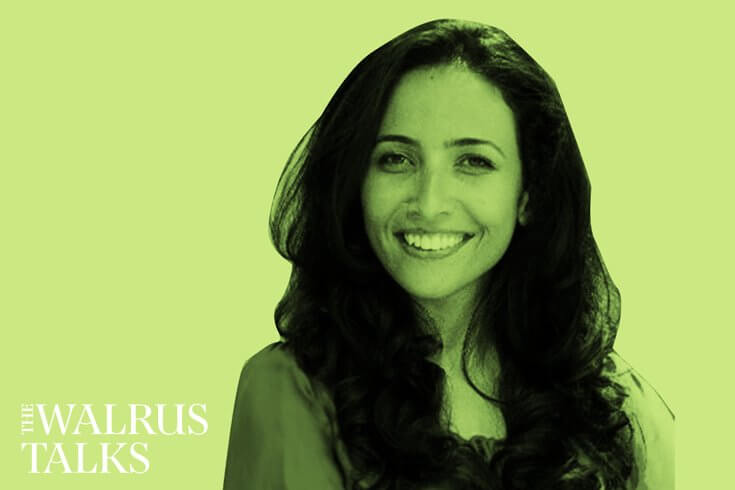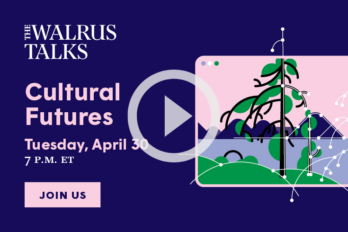Nagwan Al-Guneid, communications lead, Energy Futures Lab spoke at The Walrus Talks Energy at GLOBE2020, which took place on February 12, 2020 in Vancouver.
You can watch all The Walrus Talks speakers from this event here: The Walrus Talks Energy on YouTube
Artificial intelligence, machine learning, what’s the hype all about? It seems that AI hasn’t just been the flavor of the year, but the last three years. And bright people know, if you want to sound smart these days, just put the word AI or blockchain somewhere in your sentence.
I was first exposed to machine learning when I saw this video at my husband’s PhD defense. Machine learning is applied here to simulate blood clotting for medical education. All I remember is how fascinated I was by the application of this technology and its potential in different industries. Fast forward 13 iPhone generations later, I’m part of the Energy Futures Lab advancing the Energy.AI initiative. Energy.AI is exploring the intersection of tech applications in the energy industry to find environmental and climate solutions. By energy, I refer to oil and gas, power, electricity, heat and renewables.
Why did the EFL and its many partners implement this initiative?
First, energy transformation is happening. We need to reduce our overall emissions and from all sectors in order to be fit for the future and to thrive in this energy transition. Second, this initiative matches the [inaudible 00:01:48] death of a lab that experiments, prototypes, fails, learns and tries again. We’re playing in the solution space to reduce emissions. AI is just one tool to solve environmental problems, just as it’s applied to find cancerous lumps in radiology or to simulate clotting.
The energy sector is creating a market of good problems for AI applications. We’ve tried six prototypes at the Energy Futures Lab. I’ll talk about one that touches on physical assets and one that speaks to our discourse around energy.
First, the oil and gas facility energy efficiency. This prototype uses Google’s machine learning experience with data centers to develop and train a machine learning model to predict facility energy use. When we predict energy use, we’re talking about efficiency, which means yes, saving cost but also saving tons of emissions. The ambition here is to build an ML model that uses existing performance data from one oil and gas facility to accurately predict then optimize energy use. Google’s model for data centers predicted energy use with 99.6% accuracy, allowing Google to achieve an increase of 40% energy efficiency of an already highly efficient facility.
The second initiative is the good bots prototype. This is in relation to the polarization on energy issues. We’re essentially left with two narratives, drill, baby, drill or leave it in the ground. The discourse is binary and we see it in politicians’ rhetoric, on social media, and among many Canadians. The good bots prototype is an experiment that seeks to address how bots are currently used in social media to reinforce entrenched polarized views and how can we train good bots to identify polarizing messaging and counter with different viewpoints.
As a lab focused on experimentation, we’re always looking to draw lessons and insights. I’d like to share two. The first is about articulating the problem. In the EFL’s multi-stakeholder platform we noticed that AI innovators would often ask, “Where is the problem you’re trying to solve?” Many respond, “Climate emissions,” the big topics. Yes, but what is the problem? We learned quickly that we need to be laser focused on the specific problem, with specific data and certain parameters. So if we’re talking energy efficiency, we need to zoom in on the data, on the parameters around efficiency.
The second learning is about the need for bridgers. Bridgers are AI and energy innovators who know the energy industries and are dangerous enough in AI to understand its applications. Bridgers are translators. They advanced solutions and make the collaborative process more effective.
What I would like to end on is that we do not have a silver bullet to environmental solutions. Energy.AI is about expanding the solutions’ toolbox for climate. This is about social innovation, meeting technological innovation. This is about the value of collaboration in a multi-stakeholder platform. Collaboration is key to solving energy issues and to reducing emissions. The people who hold the problem do not necessarily have the knowledge around AI as a solution, and AI folks do not have the deep knowledge of energy problems that AI can solve. The EFL experimented with two data points here, energy and technology. Imagine the possibilities if we add a third or a fourth discipline into this prototype. I’m sure there are at least 30 ideas in this room. We need to democratize knowledge. We need to connect and bridge between disciplines to advance multiple solutions to reduce emissions, solve environmental challenges, and thrive in this energy transition. Thank you.






